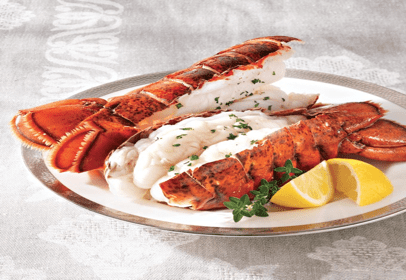
When you cook frozen lobster tails, it is best to thaw them first. You can either thaw them in a microwave or in the refrigerator. If you thaw them in the refrigerator, it will take anywhere from eight to twelve hours for them to fully thaw and same as with beef, if you decide to thaw them in the microwave, you will need to cook them immediately after thawing. Thawing the lobster tails before cooking will make them much tendered than if you were to cook them frozen.
Methods of Preparing Lobster Tails
Baking
Many people like to broil lobster tails but it is rather difficult to keep the sections from overcooking, so it is a little safer to bake them.
- Once the lobster tails are thawed, you can brush them lightly with olive oil or butter and they put them in the oven at 400 degrees for approximately 8 to 10 minutes (you will need to cook them a little longer than this if they are still frozen).
- Once they are done, there are many different additions you can serve with the lobster tails, such as lemon slices or one of many different sauces.
Boiling
Another method of cooking lobster tails is to boil them. You will need to put a large pot of water on the stove to boil.
- Add in one teaspoon of salt for every quart of water
- Once the water is boiling, you drop the lobster tails into it, which will cease the boiling for a short time. Once the boiling begins again, you will lower the heat to medium, or medium high, and this is when the timer should begin.
- For 1 to 3 ounces of meat, you will want to boil them for approximately 3 to 5 minutes. For every ounce after that, you will need to add one to two minutes to the boiling time.
Steaming
Steaming lobster tails is another cooking option that doesn’t take very long-only about five to seven minutes. You can use water as the liquid for steaming, or you can use white wine (using white wine can also double as a sauce after the lobster tails are finished cooking). It is often a good idea to stick a wooden skewer through the lobster tails since steaming them causes them to shrivel slightly.
Broiling Large Lobster Tails
When cooking a large lobster tail, the trick will be to cook it all the way through without scorching or drying out the top. If you do cook it too long, the meat will be tough and chewy. The best way to approach broiling a large lobster tail is to first thaw it, then cut open the top of the shell lengthwise. You will need a heavy pair of kitchen shears to do this, and you will want to cut just deep enough that you do not cut the bottom of the shell. You may need to use a large knife to cut through the meat and you will then need to split the shell open. Then, you will put it in a roasting pan just underneath the broiler. Cutting the lobster tail open like this will help expose the meat to the broiler so that it will cook evenly and prevent the shell from burning or drying out.
Cooking Lobsters “Piggy Back”
Another way of broiling lobster is what is referred to as “piggy back.” This method can also be used when grilling lobsters as well. Basically, what you will need to do is remove the meat from the inside of the lobster shell for cooking. This will help the lobster tail cook more thoroughly and evenly.
- Cut the outer shell down the center, leaving the fan tail and the underside membrane both intact
- Next carefully lift the meat through the slit in the shell
- Place the lobster meat on a roasting pan (in a small amount of water to prevent drying) membrane side up.
- Then place the roasting pan and lobster tails just under the broiler. You will cook these at the same amount of time required for boiling, the only difference being that you will need to turn them over and baste them again halfway through
- You will need to do the same to remove the lobster meat from the shell if you are going to use the “piggy back” method for grilling. You will want to cook the membrane side first in grilling, as well. Then, just as with broiling, you will need to turn the lobster tail halfway through, and baste it again, as well.
